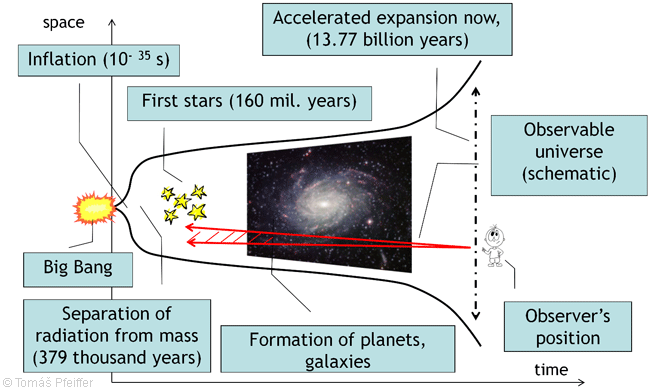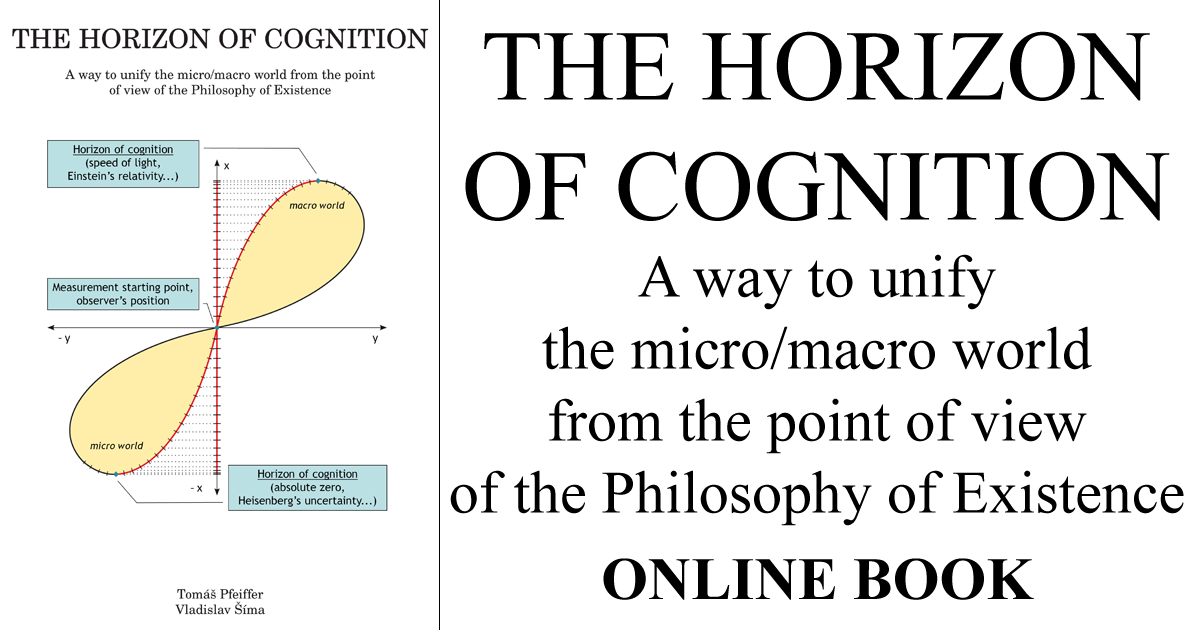Chapter 1
Introduction
1.4 Cosmology and dark matter/energy
Cosmology is a scientific field that studies the origin, evolution, structure and future of the universe. The present conceptions about the origin of the universe and evolution are illustrated in Fig. 1.4.

Figure 1.4: Schematic illustration of the origin, expansion and observable part of the universe according to current understanding of the Big Bang, inflation and accelerated expansion. We only perceive a tiny part of the universe, and even then looking just into the past. Based on observation it is therefore difficult to assess what our universe actually is (now) and how it will be in the future.
According to most contemporary theories, gravity is the main force structuring the universe. Most cosmological models are based on the idea that the universe was created with the Big Bang about 13.77 billion years ago. At that time, there were no differences between the macro and the micro world; the properties of the universe were governed by the particles within it.
A comprehensive information about cosmology you can find for instance in [18].
Soon after the creation of the universe, a phenomenon called inflation occurred (according to contemporary theories): in a fraction of second, the young universe expanded rapidly and evened out the creases in space-time to such an extent that according to current observations, two parallel rays remain parallel when moving through space – regardless of the distance covered or time passed. Material objects cause the curvature of spacetime in their surroundings, and this curvature is the cause of the gravitational effect between them.
About 379 thousand years later ([18], page 237), the temperature dropped (below 3000 K) as the universe expanded and electrons and nuclei combined creating the first atoms. This reduced the number of free electrons that were scattering photons. The universe thus became transparent to radiation, which could now develop independently of matter. Today, cosmic microwave background radiation can be observed passing through the universe in all directions.
The temperature of this radiation constantly falls as the universe expands (thus characterising its size). Based on the current measurements, the radiation can be assigned a temperature of about 2.75K, using the theory of black body radiation.
Ever since, (according to our current knowledge) the universe has been constantly expanding into the universe as we know it.
Observations show us that the universe looks almost the same in every direction and that at larger scales, matter is homogeneously spread throughout it. The observable universe (of which we can only observe a negligible part) enables us to infer the universe’s geometry, but because we are observing the universe from within, we are not able to say anything about its overall topology (its shape or layout, or any twists or curves in the universe as a whole). We also do not know how big the universe is, or if it is finite or infinite.
As the universe expands, the objects within it are moving further away from each other, just like spots on a balloon that is being blown up. Well known Hubble’s law can be applied here ([18], page 25):
v = Hr (1.2)
where v is the velocity of recession, H Hubble constant and r the distance of the galaxy from the Earth. Equation (1.2) explains that the further away an object is from us, the faster it moves. The oldest identified object in the universe (and hence also the object furthest away from us) is the galaxy GNz11 (published in 2016, [19]), which we can observe the way it was 13.4 billion years ago (approximately 400 million years after the Big Bang). Observations show that this galaxy is moving (i.e. was moving) almost at the speed of light (about 295 000 km.s−1). We can also see that new stars are being born (i.e. were being born) about 20 times faster in GN-z11 than in the Milky Way [19].
Astronomical observations are limited, because the redshift means that the radiation of the object moving away shifts into the infrared spectrum making it harder to detect. We are also not able to see objects that are moving away from us faster than the speed of light. Such objects most likely do exist (due to the expansion, at a sufficiently large distance, objects are able to move away from each other faster than the speed of light) but we are not able to detect them. It is an event horizon beyond which we are not able to see.
Up until the last century, it was presumed that gravity gradually slowed down the expansion of the universe and there were speculations as to whether gravity would at some point prevail over expansion and the universe would again contract into a singularity.
In 1998, however, by observing exploding supernovae in a distant galaxy, it was found that the supernovae were further away from us (they radiated less) than their redshift suggested (this discovery was awarded with the Nobel Prize in 2011 [20]). It seems that since the Big Bang, the expansion of the universe has accelerated and the supernovae are further away than the redshift indicates.
This discovery led to a thorough reassessment of cosmological theories. Scientists assume that it is an energetic manifestation of vacuum, which creates a repulsive force and expands free space. This repulsive force is called dark energy ([18], page 101).
Observations showed that galaxies are held together by a force greater than the compound gravity of all the stars within them. This gave birth to the term dark matter ([18], page 248). Dark matter is a part of every galaxy and there should be more dark matter in the universe than there is ordinary visible matter.
According to our current knowledge, it seems that stars and planets only account for a mere 5% of the forces we can observe in the universe. In many sources today we can see that another 27% is accounted for by dark matter and 68% by dark energy.
Understanding dark matter and dark energy is one of the greatest challenges in physics today and is also one of the greatest mysteries of the universe.
With all due respect to scientific research and the meticulous and rigorous work of scientific teams, we take the liberty to disagree with the current theories regarding the age of the universe, cosmic inflation and the current understanding of dark matter and dark energy. The observed smoothness and homogeneity of the universe and the acceleration of its expansion may, in our opinion, also have a different cause and explanation.
So far, we have presented a very brief and basic overview of the current scientific knowledge and understanding of the micro and macro world. Now let us look at these two worlds through the eyes of the Philosophy of Existence.

